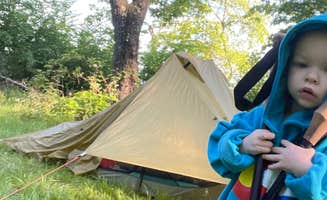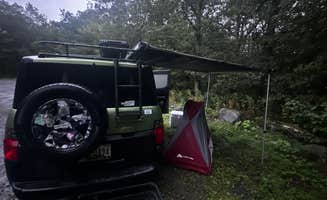Primitive camping near Tewksbury, New Jersey primarily consists of hike-in sites connected to the Appalachian Trail network. The region sits within the Delaware River watershed at elevations ranging from 400-1500 feet, creating varied terrain for backcountry campers. Most sites require permits and don't allow ground fires due to forest management regulations in the Delaware Water Gap and surrounding wilderness areas.
What to do
Trail exploration from Thunder Swamp Trailhead: This dispersed camping area serves as an access point for extensive hiking networks. "Trailhead parking was chill for a night. No trouble. Tons of hiking. Went down Saw Creek trail to a marsh," reports Jason R. The parking area provides shade and serves as a base for overnight stays before exploring the trail system.
Rocky scrambling at Bake Oven Knob: Located along the Appalachian Trail, this area offers both overnight parking for self-contained vehicles and hiking access. "The hike to the overlook is really lovely; short and rocky," notes Dani T., who has stayed overnight in their van multiple times. The trail to the overlook provides a challenging but rewarding experience with views from the Blue Mountain ridge.
Hammock camping at established sites: The terrain throughout the region favors hammock setup over tent camping due to slopes and rocky ground. Designated backcountry sites typically have trees suitable for hammock suspension systems. Terrain conditions often make hammock camping more practical than ground tents in most areas around Sunfish Pond and other protected zones.
What campers like
Bear management systems: Appalachian Trail Designated Backpacker Campsite 2 provides bear boxes for food storage. Katharine T. confirms the site is "well maintained with bear boxes provided," making wildlife management more straightforward for backpackers. These secured storage containers reduce wildlife encounters in an area with active black bear populations.
Balance of community and solitude: Campers appreciate the option to either cluster with others or find more remote spots. "There's plenty of space. We camped nearer to others but there are secluded spots too," notes Katharine T. about her section hike through Delaware Water Gap on the Appalachian Trail. The designated sites allow for social camping or more private setups based on preference.
Vehicle overnight options at trailheads: For those seeking quick overnight stays, several trailheads permit vehicle camping. Benjamin H. describes Thunder Swamp Trailhead as "a gravel parking lot. Plenty of shade. No one bothered me." These informal sites offer convenience for through-hikers or weekend adventurers needing a simple base camp.
What you should know
Limited water access: Water sources are scarce near many primitive sites. Sunfish Pond serves as one water source, but planning is essential. "No Water (nearest is sunfish pond - easy hike about a 1 round trip)," advises Katharine T. about camping conditions. Hikers should carry sufficient water or plan routes with reliable natural sources.
Camping restrictions: Numerous areas have strict camping prohibitions, particularly around sensitive ecological zones. Signage throughout Worthington State Forest clearly marks where camping is prohibited, with designated sites being the only legal options in many areas. Permits may be required depending on location and duration of stay.
Unmarked but established sites: Many camping areas lack official markers but show evidence of previous use. Finding suitable spots requires observation skills. The backcountry sites along the Appalachian Trail corridor conform to Leave No Trace principles with minimal impact zones where previous camping has occurred.
Tips for camping with families
Choose sheltered locations: Areas with natural windbreaks provide more comfortable conditions, especially during spring and fall when temperatures fluctuate significantly. Sites near but not directly on ridgelines offer better protection while maintaining access to views and trails.
Prepare for limited facilities: Floyd Bennett Field and other primitive sites in the region have no running water or toilets. Families must bring all necessities, including water filtration systems and portable waste management solutions. Children should be prepared for truly rustic conditions with no amenity support.
Plan shorter hiking distances: When camping with children, select sites with shorter approach hikes. Most primitive sites near Tewksbury require hiking in with all gear, making distance a critical factor for families. Routes under 2 miles one-way work best for younger children carrying light packs.
Tips from RVers
Self-contained vehicles only: No hookups or dump stations exist at any primitive sites near Tewksbury. RVs must be fully self-contained with adequate water, power, and waste storage for the duration of the stay. Small campervans and truck campers navigate the access roads more successfully than larger motorhomes.
Parking lot limitations: Appalachian Trail Campsite and similar areas have unpaved, limited-sized parking areas. Larger rigs cannot access most primitive sites in the region. Vehicles over 20 feet in length will struggle with turn-around space at many trailheads and forest access points.
Seasonal road conditions: Access roads deteriorate significantly during winter and spring thaw. Many forest roads become impassable for non-4WD vehicles, restricting RV access seasonally. Call ranger stations for current road conditions before attempting access during shoulder seasons.



